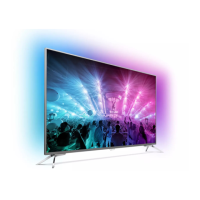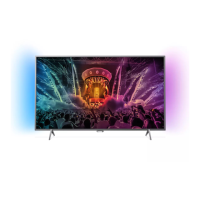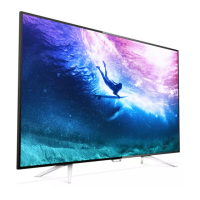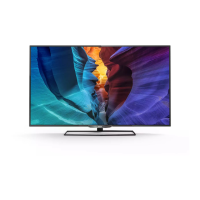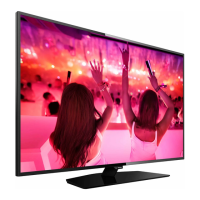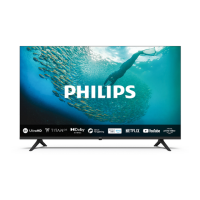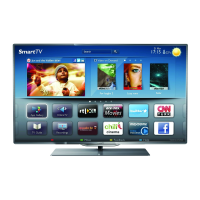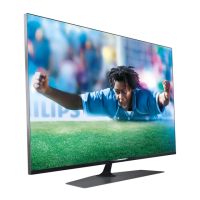Do you have a question about the Philips 49PUS8303 and is the answer not in the manual?
Explains the new Home launcher and accessing settings from Home.
Details on finding and using apps and the Philips TV Collection.
Instructions to read safety information before using the TV.
Guidance on installing the TV stand or wall mount for safe setup.
Recommendations for optimal TV placement regarding lighting and viewing.
Instructions for connecting the power cable securely and safely.
How to connect the antenna cable for DVB-T and DVB-C input signals.
Instructions for connecting the satellite F-type connector to the SAT connection.
Explains the functions of each button on the top, middle, and bottom of the remote.
Steps to pair the Bluetooth remote control with the TV for advanced features.
How to use the voice search feature via the remote control's microphone.
Details on using the Qwerty/Azerty keyboard on the remote for text input.
Instructions for replacing the remote control batteries.
Guidance on how to clean the remote control safely.
How to switch the TV on, off, or to standby mode using the remote or TV controls.
Basic TV operations using the joystick key when the remote is unavailable.
Steps for installing TV channels, including antenna and satellite options.
Information about channel lists, icons, radio stations, and opening/searching.
How to sort and filter channel lists by TV, Radio, Free-to-Air, or Scrambled.
How to tune to channels, switch channels, lock/unlock channels, and set parental ratings.
Setting options like subtitles and audio language for channels.
Setting preferred subtitle languages for digital broadcasts.
Setting preferred audio languages for digital broadcasts.
Viewing CAM and operator information for Common Interface slots.
How to block HbbTV pages on specific channels.
Viewing details of selected programmes and accessing TV Guide.
Switching the sound of analogue channels between Mono and Stereo.
How to change the sequence of channels within a Favourites List.
Creating and managing favourite channel lists for easier channel zapping.
Adding a consecutive range of channels to a Favourites List.
How to rename an existing Favourites List.
Procedure for deleting a Favourites List.
Linking the TV Guide to your Favourite List for program viewing.
How to open, select pages, and use Text/Teletext features.
Text Options and Setup for language and Text 2.5.
Understanding interactive TV features like HbbTV and MHEG.
How to switch on HbbTV in TV settings to view HbbTV pages.
Instructions on opening, navigating, and closing iTV pages.
Guide to installing up to 4 satellites, including Unicable and MDU systems.
How to change satellite installation settings for country and tuners.
Adjusting expert settings for transponder and LNB when normal installation fails.
Using CAM modules with smart cards for descrambling satellite channels.
Information on satellite channel packages, free-to-air, and subscription options.
Connecting the TV using a Unicable system and assigning user band numbers.
Explanation of user band numbers and frequencies for Unicable systems.
Procedure to manually update channels from settings.
Adding an additional satellite and changing installation settings.
Steps to remove satellites and their associated channels.
Expert guide to manually install channels from a transponder.
Troubleshooting common satellite installation issues.
Updating channels automatically or manually for antenna reception.
Reinstalling all channels or performing a full TV installation.
Configuring DVB-T/C reception, channel installation, and number conflicts.
Selecting Quick Scan or Full Scan methods for finding channels.
Adjusting frequency step size and selecting channel types.
Checking and improving the signal quality of digital channels.
Manually installing analogue channels one by one.
Setting the TV system and searching for channels.
Copying channel lists between TVs for easy setup.
Checking the current version of the channel list.
Uploading a channel list to a TV from a USB drive.
General guidance on connecting devices with quality cables for best performance.
Connecting antenna cables through a set-top box or recorder.
Information on HDMI quality, high-speed cables, and HDCP copy protection.
Connecting smartphones/tablets via MHL for screen sharing and charging.
Operating HDMI CEC-compatible devices and troubleshooting EasyLink.
Using CI+ modules and smart cards to watch premium HD programmes.
Instructions for inserting the smart card into the CAM module.
Setting PIN codes for CAMs for channel access.
Connecting Home Theatre Systems via HDMI ARC for audio and video.
Troubleshooting sound issues with Home Theatre Systems.
Connecting smartphones and tablets wirelessly or via wired connection.
Connecting a Blu-ray Disc player using HDMI and EasyLink CEC.
Connecting a DVD player using HDMI and EasyLink CEC.
Pairing, selecting, and removing Bluetooth devices like gamepads.
Connecting headphones and adjusting their volume separately.
Connecting game consoles via HDMI or Y Pb Pr for optimal quality.
Connecting and formatting a USB Hard Drive for pause/record features.
Connecting and configuring a USB keyboard for text input.
Procedure for formatting a USB Hard Drive for recordings or apps.
Viewing photos, music, and videos from a USB flash drive.
Connecting a digital photo camera to view photos on the TV.
Connecting a camcorder via HDMI for best quality video.
Connecting a computer to use the TV as a PC monitor via HDMI.
Connecting the TV to a home network wirelessly or via Ethernet.
Steps to connect to a wireless network, including entering encryption keys.
Connecting to a network using WPS button or PIN code.
Troubleshooting common network and internet connection issues.
Connecting the TV to a network router using an Ethernet cable.
Viewing network settings and configuring static IP or Digital Media Renderer.
Setting a unique name for the TV within the home network.
Clearing Philips server registration, logins, and browsing data.
Signing into Google to access apps, games, and personalized recommendations.
Accessing Android-specific settings like apps, storage, and speech.
Overview of the Home screen, channels, apps, and Play Next features.
Installing apps from Philips TV Collection or Google Play Store.
Agreeing to Terms of Use for Philips TV Collection apps.
Configuring privacy settings for Philips TV Collection apps.
Introduction to apps on TV, their sources, and internet connection requirements.
Using Google Play for Movies & TV, Music, and Games.
How to start and stop apps from the Home screen.
Locking apps by age rating or setting up restricted profiles.
Locking 18+ rated apps from Philips apps and setting Child Lock.
Setting up a restricted profile to limit app access on the Home menu.
Stopping apps, clearing cache, and uninstalling apps for performance.
Checking TV memory usage for apps, videos, and music.
Using a USB Hard Drive to extend TV memory for more apps.
Browsing the Internet on the TV, including limitations and page display.
Using additional features in the Internet browser like tabs, bookmarks, and settings.
Using the TV Menu as an alternative Home menu when internet is unavailable.
How to open the TV Menu to access TV functions.
Switching between connected devices like tuners, USB drives, and players.
Switching on disc players and TV from standby to play discs immediately.
Setting specific options for connected TV input devices.
Operating devices via HDMI CEC and viewing device information.
Changing names and types of connected devices for easier identification.
Updating the Sources menu to include recently connected devices.
Information on connecting the TV to a network.
Pairing, selecting, and removing wireless Bluetooth devices.
Adjusting picture settings like style, colour, contrast, sharpness, and brightness.
Selecting preset picture styles or customizing them.
Detailed adjustments for picture colour saturation, contrast, sharpness, and brightness.
Advanced colour settings, enhancement, and gamut adjustments.
Information on ISF Calibration for optimal picture settings.
Adjusting hue, saturation, and intensity for colour control.
Selecting RGB only mode for picture colour or turning it off.
Using contrast modes for optimized picture or energy savings.
Information on HDR playback and HDR upscaling capabilities.
Enabling HDR Premium for superior contrast and brightness.
Enhancing details in dark, middle, and light areas of the picture.
Adjusting video contrast and gamma for picture luminance.
Reducing noise and MPEG artefacts for cleaner picture quality.
Adjusting motion styles and perfect natural motion for smoother picture.
Easy steps to redo initial picture settings.
Adjusting picture format to fill screen or maintain aspect ratio.
Selecting sound styles, restoring styles, and expert mode settings.
Choosing preset sound styles for movies, music, games, and news.
Detailed sound settings including DTS TruSurround and clear dialogue.
Adjusting equalizer levels and headphone volume separately.
Optimizing sound reproduction based on TV placement (stand or wall).
Advanced settings for volume control, delta volume, and audio out.
Configuring digital output formats for optical and HDMI ARC sound signals.
Selecting Ambilight styles to follow video, audio, colour, or flag dynamics.
Setting Ambilight to follow video dynamics with various styles.
Setting Ambilight to follow audio dynamics with various styles.
Setting Ambilight to follow preset colour styles.
Configuring Philips Hue bulbs to synchronize with Ambilight.
Neutralizing wall colour influence and ISF tuning for Ambilight.
Adjusting energy saving levels, screen off timer, and ambient light sensor.
Setting the automatic TV switch off timer for energy saving.
Configuring the keyboard layout for an installed USB keyboard.
Selecting the TV's location (Home or Shop) for picture and settings.
Adjusting shop settings, picture, audio, logos, and demo autostart.
Setting up USB Hard Drive, adjusting shop settings, and logos.
Operating HDMI CEC-compatible devices and troubleshooting EasyLink.
Adjusting HDMI Ultra HD settings for device compatibility and signal quality.
Advanced settings for HbbTV, CAM profile name, and resetting TV settings.
Setting clock, region, and language preferences for the TV.
Changing TV menu language and setting audio/subtitle preference languages.
Manually correcting the clock or setting time zones and sleep timers.
Viewing installed apps, checking free space, and downloading/uninstalling apps.
Enabling universal access features for hearing or visually impaired users.
Enabling special audio and subtitles for the hard of hearing.
Enabling audio description and mixed volume for visually impaired users.
Setting PIN codes for apps, programs, CAMs, and managing parental controls.
Locking apps by age rating or setting up a restricted profile.
Viewing media files from a computer or NAS over the home network.
Adding folders/files to favourites and viewing favourite files.
Viewing most popular and last played media files.
Viewing media files from a connected USB flash drive or hard drive.
Opening video folders, playing videos, and managing video options.
Opening photo folders, viewing photos, and managing photo options.
Viewing 360 photos and using playback controls and options.
Browsing photo files and setting slide show speeds.
Opening music folders, playing music, and managing music options.
Browsing music files and marking them as favourites.
Requirements for using the TV Guide and its data sources.
Information on how TV Guide data is received and set.
Setting the TV to receive TV Guide information from the Internet.
Troubleshooting missing recordings due to TV Guide data changes.
Opening, tuning to programmes, viewing details, and changing days.
Setting reminders for programmes to get alerts.
Searching for programmes by genre and setting reminders or recordings.
Viewing and managing set reminders.
Scheduling recordings for upcoming or ongoing programmes.
Requirements and procedures for recording digital TV broadcasts.
Recording the currently watched programme immediately.
Scheduling recordings for future programmes using TV Guide data.
Viewing and managing recordings, including filtering and renaming.
Resolving conflicts when two scheduled recordings overlap in time.
Setting automatic time margin at the end of scheduled recordings.
Scheduling recordings manually by setting tuner, channel, start, and end time.
Pausing and resuming digital TV broadcasts using a USB Hard Drive.
Replaying the currently watched broadcast for a few seconds.
Using the Philips TV Remote App for media control and remote functions.
Casting apps from mobile devices to the TV using Google Cast.
Steps to cast an app to the TV screen using Google Cast.
Adding AirPlay functionality by installing Android apps.
Connecting MHL-compliant mobile devices for screen sharing and charging.
Requirements for playing games from Philips TV Collection, Google Play, or consoles.
Connecting wireless gamepads to the TV for gaming.
Starting games from a connected game console.
Selecting Ambilight styles to follow video, audio, colour, or flag dynamics.
Setting Ambilight to follow video dynamics with various styles.
Setting Ambilight to follow audio dynamics with various styles.
Setting Ambilight to follow preset colour styles.
How to switch off Ambilight using the remote control.
More information on Ambilight settings in Help.
Switching on Ambilight lounge light when the TV is in standby.
Introduction to Top Picks, its recommendations, and terms of use.
Understanding Now on TV for popular programmes and personalized recommendations.
How to open, navigate, and tune to programmes in Now on TV.
Watching missed or favorite TV programmes via TV on Demand.
Opening TV on Demand, selecting programmes, and renting movies.
Renting movies from online video stores and payment methods.
Information on enjoying Netflix with a membership subscription on the TV.
Overview of Alexa voice control, requirements, and Alexa Skills.
Steps to set up and use the Alexa client service on your Philips Android TV.
Updating TV software from the Internet or via USB.
Viewing the current TV software version and release notes.
Enabling automatic software updates for the TV.
Information on open source software used in the TV.
Details about TP Vision's TV software under open source licenses.
Receiving announcements on new TV software availability.
Information on the European Energy Label and product energy consumption.
Disposal instructions for old products and batteries.
Specifications for mains power, ambient temperature, and power saving features.
Details on the TV's operating system, Android OS.
Specifications for aerial, tuner bands, DVB, and satellite reception.
Information on diagonal screen size and display resolution.
Supported input resolutions and refresh rates for video and computer.
Details on TV side and bottom connectivity ports like USB, HDMI, and LAN.
Physical dimensions and weights of the TV models with and without stand.
Specifications for output power, Dolby Audio, and DTS-HD Premium Sound.
Details on media connections, playback formats, and subtitle support.
Benefits of registering your TV and how to access support.
How to open and use the on-screen Help feature.
Solutions for common problems like TV not switching on or remote issues.
Troubleshooting TV power and remote control issues.
Troubleshooting issues related to digital channel reception and list selection.
Troubleshooting picture issues like no picture, distorted picture, or poor reception.
Troubleshooting sound issues like no sound or poor sound quality.
Troubleshooting HDMI and USB connection issues.
Troubleshooting Wi-Fi, Internet, and slow connection issues.
How to change the menu language back to your preferred language.
Consulting online support for Philips TV related problems.
Contacting Consumer Care for support, repair, and finding model/serial numbers.
Important safety instructions to prevent electric shock, fire, and injury.
Precautions to avoid electric shock and fire hazards.
Preventing toppling and ensuring child safety.
Warning about coin-type batteries being a swallowing hazard for children.
Ensuring adequate ventilation to prevent overheating.
Disconnecting TV during lightning storms and avoiding contact.
Safety precautions for lifting, carrying, and mounting the TV.
Preventing condensation by avoiding direct sunlight and extreme humidity.
Instructions for cleaning the TV screen and avoiding stationary images.
Legal terms, warranties, and safety warnings for the TV product.
Declaration of conformity with EU directives for the television.
Information on electromagnetic field (EMF) standards and safety measures.
Viewing terms of use, privacy policy, and privacy settings for Smart TV.
Information on terms of use for Philips TV Collection apps.
Trademarks and logos related to MHL technology.
Trademarks and logos related to HDMI High-Definition Multimedia Interface.
Trademarks and logos related to Dolby Audio technology.
Information on DTS patents and trademarks.
Trademarks and logos related to Wi-Fi Alliance certification.
Information on Kensington trademarks for security features.
All other registered and unregistered trademarks are property of their owners.
Disclaimer for changes or termination of third-party services/software.
Explains the new Home launcher and accessing settings from Home.
Details on finding and using apps and the Philips TV Collection.
Instructions to read safety information before using the TV.
Guidance on installing the TV stand or wall mount for safe setup.
Recommendations for optimal TV placement regarding lighting and viewing.
Instructions for connecting the power cable securely and safely.
How to connect the antenna cable for DVB-T and DVB-C input signals.
Instructions for connecting the satellite F-type connector to the SAT connection.
Explains the functions of each button on the top, middle, and bottom of the remote.
Steps to pair the Bluetooth remote control with the TV for advanced features.
How to use the voice search feature via the remote control's microphone.
Details on using the Qwerty/Azerty keyboard on the remote for text input.
Instructions for replacing the remote control batteries.
Guidance on how to clean the remote control safely.
How to switch the TV on, off, or to standby mode using the remote or TV controls.
Basic TV operations using the joystick key when the remote is unavailable.
Steps for installing TV channels, including antenna and satellite options.
Information about channel lists, icons, radio stations, and opening/searching.
How to sort and filter channel lists by TV, Radio, Free-to-Air, or Scrambled.
How to tune to channels, switch channels, lock/unlock channels, and set parental ratings.
Setting options like subtitles and audio language for channels.
Setting preferred subtitle languages for digital broadcasts.
Setting preferred audio languages for digital broadcasts.
Viewing CAM and operator information for Common Interface slots.
How to block HbbTV pages on specific channels.
Viewing details of selected programmes and accessing TV Guide.
Switching the sound of analogue channels between Mono and Stereo.
How to change the sequence of channels within a Favourites List.
Creating and managing favourite channel lists for easier channel zapping.
Adding a consecutive range of channels to a Favourites List.
How to rename an existing Favourites List.
Procedure for deleting a Favourites List.
Linking the TV Guide to your Favourite List for program viewing.
How to open, select pages, and use Text/Teletext features.
Text Options and Setup for language and Text 2.5.
Understanding interactive TV features like HbbTV and MHEG.
How to switch on HbbTV in TV settings to view HbbTV pages.
Instructions on opening, navigating, and closing iTV pages.
Guide to installing up to 4 satellites, including Unicable and MDU systems.
How to change satellite installation settings for country and tuners.
Adjusting expert settings for transponder and LNB when normal installation fails.
Using CAM modules with smart cards for descrambling satellite channels.
Information on satellite channel packages, free-to-air, and subscription options.
Connecting the TV using a Unicable system and assigning user band numbers.
Explanation of user band numbers and frequencies for Unicable systems.
Procedure to manually update channels from settings.
Adding an additional satellite and changing installation settings.
Steps to remove satellites and their associated channels.
Expert guide to manually install channels from a transponder.
Troubleshooting common satellite installation issues.
Updating channels automatically or manually for antenna reception.
Reinstalling all channels or performing a full TV installation.
Configuring DVB-T/C reception, channel installation, and number conflicts.
Selecting Quick Scan or Full Scan methods for finding channels.
Adjusting frequency step size and selecting channel types.
Checking and improving the signal quality of digital channels.
Manually installing analogue channels one by one.
Setting the TV system and searching for channels.
Copying channel lists between TVs for easy setup.
Checking the current version of the channel list.
Uploading a channel list to a TV from a USB drive.
General guidance on connecting devices with quality cables for best performance.
Connecting antenna cables through a set-top box or recorder.
Information on HDMI quality, high-speed cables, and HDCP copy protection.
Connecting smartphones/tablets via MHL for screen sharing and charging.
Operating HDMI CEC-compatible devices and troubleshooting EasyLink.
Using CI+ modules and smart cards to watch premium HD programmes.
Instructions for inserting the smart card into the CAM module.
Setting PIN codes for CAMs for channel access.
Connecting Home Theatre Systems via HDMI ARC for audio and video.
Troubleshooting sound issues with Home Theatre Systems.
Connecting smartphones and tablets wirelessly or via wired connection.
Connecting a Blu-ray Disc player using HDMI and EasyLink CEC.
Connecting a DVD player using HDMI and EasyLink CEC.
Pairing, selecting, and removing Bluetooth devices like gamepads.
Connecting headphones and adjusting their volume separately.
Connecting game consoles via HDMI or Y Pb Pr for optimal quality.
Connecting and formatting a USB Hard Drive for pause/record features.
Connecting and configuring a USB keyboard for text input.
Procedure for formatting a USB Hard Drive for recordings or apps.
Viewing photos, music, and videos from a USB flash drive.
Connecting a digital photo camera to view photos on the TV.
Connecting a camcorder via HDMI for best quality video.
Connecting a computer to use the TV as a PC monitor via HDMI.
Connecting the TV to a home network wirelessly or via Ethernet.
Steps to connect to a wireless network, including entering encryption keys.
Connecting to a network using WPS button or PIN code.
Troubleshooting common network and internet connection issues.
Connecting the TV to a network router using an Ethernet cable.
Viewing network settings and configuring static IP or Digital Media Renderer.
Setting a unique name for the TV within the home network.
Clearing Philips server registration, logins, and browsing data.
Signing into Google to access apps, games, and personalized recommendations.
Accessing Android-specific settings like apps, storage, and speech.
Overview of the Home screen, channels, apps, and Play Next features.
Installing apps from Philips TV Collection or Google Play Store.
Agreeing to Terms of Use for Philips TV Collection apps.
Configuring privacy settings for Philips TV Collection apps.
Introduction to apps on TV, their sources, and internet connection requirements.
Using Google Play for Movies & TV, Music, and Games.
How to start and stop apps from the Home screen.
Locking apps by age rating or setting up restricted profiles.
Locking 18+ rated apps from Philips apps and setting Child Lock.
Setting up a restricted profile to limit app access on the Home menu.
Stopping apps, clearing cache, and uninstalling apps for performance.
Checking TV memory usage for apps, videos, and music.
Using a USB Hard Drive to extend TV memory for more apps.
Browsing the Internet on the TV, including limitations and page display.
Using additional features in the Internet browser like tabs, bookmarks, and settings.
Using the TV Menu as an alternative Home menu when internet is unavailable.
How to open the TV Menu to access TV functions.
Switching between connected devices like tuners, USB drives, and players.
Switching on disc players and TV from standby to play discs immediately.
Setting specific options for connected TV input devices.
Operating devices via HDMI CEC and viewing device information.
Changing names and types of connected devices for easier identification.
Updating the Sources menu to include recently connected devices.
Information on connecting the TV to a network.
Pairing, selecting, and removing wireless Bluetooth devices.
Adjusting picture settings like style, colour, contrast, sharpness, and brightness.
Selecting preset picture styles or customizing them.
Detailed adjustments for picture colour saturation, contrast, sharpness, and brightness.
Advanced colour settings, enhancement, and gamut adjustments.
Information on ISF Calibration for optimal picture settings.
Adjusting hue, saturation, and intensity for colour control.
Selecting RGB only mode for picture colour or turning it off.
Using contrast modes for optimized picture or energy savings.
Information on HDR playback and HDR upscaling capabilities.
Enabling HDR Premium for superior contrast and brightness.
Enhancing details in dark, middle, and light areas of the picture.
Adjusting video contrast and gamma for picture luminance.
Reducing noise and MPEG artefacts for cleaner picture quality.
Adjusting motion styles and perfect natural motion for smoother picture.
Easy steps to redo initial picture settings.
Adjusting picture format to fill screen or maintain aspect ratio.
Selecting sound styles, restoring styles, and expert mode settings.
Choosing preset sound styles for movies, music, games, and news.
Detailed sound settings including DTS TruSurround and clear dialogue.
Adjusting equalizer levels and headphone volume separately.
Optimizing sound reproduction based on TV placement (stand or wall).
Advanced settings for volume control, delta volume, and audio out.
Configuring digital output formats for optical and HDMI ARC sound signals.
Selecting Ambilight styles to follow video, audio, colour, or flag dynamics.
Setting Ambilight to follow video dynamics with various styles.
Setting Ambilight to follow audio dynamics with various styles.
Setting Ambilight to follow preset colour styles.
Configuring Philips Hue bulbs to synchronize with Ambilight.
Neutralizing wall colour influence and ISF tuning for Ambilight.
Adjusting energy saving levels, screen off timer, and ambient light sensor.
Setting the automatic TV switch off timer for energy saving.
Configuring the keyboard layout for an installed USB keyboard.
Selecting the TV's location (Home or Shop) for picture and settings.
Adjusting shop settings, picture, audio, logos, and demo autostart.
Setting up USB Hard Drive, adjusting shop settings, and logos.
Operating HDMI CEC-compatible devices and troubleshooting EasyLink.
Adjusting HDMI Ultra HD settings for device compatibility and signal quality.
Advanced settings for HbbTV, CAM profile name, and resetting TV settings.
Setting clock, region, and language preferences for the TV.
Changing TV menu language and setting audio/subtitle preference languages.
Manually correcting the clock or setting time zones and sleep timers.
Viewing installed apps, checking free space, and downloading/uninstalling apps.
Enabling universal access features for hearing or visually impaired users.
Enabling special audio and subtitles for the hard of hearing.
Enabling audio description and mixed volume for visually impaired users.
Setting PIN codes for apps, programs, CAMs, and managing parental controls.
Locking apps by age rating or setting up a restricted profile.
Viewing media files from a computer or NAS over the home network.
Adding folders/files to favourites and viewing favourite files.
Viewing most popular and last played media files.
Viewing media files from a connected USB flash drive or hard drive.
Opening video folders, playing videos, and managing video options.
Opening photo folders, viewing photos, and managing photo options.
Viewing 360 photos and using playback controls and options.
Browsing photo files and setting slide show speeds.
Opening music folders, playing music, and managing music options.
Browsing music files and marking them as favourites.
Requirements for using the TV Guide and its data sources.
Information on how TV Guide data is received and set.
Setting the TV to receive TV Guide information from the Internet.
Troubleshooting missing recordings due to TV Guide data changes.
Opening, tuning to programmes, viewing details, and changing days.
Setting reminders for programmes to get alerts.
Searching for programmes by genre and setting reminders or recordings.
Viewing and managing set reminders.
Scheduling recordings for upcoming or ongoing programmes.
Requirements and procedures for recording digital TV broadcasts.
Recording the currently watched programme immediately.
Scheduling recordings for future programmes using TV Guide data.
Viewing and managing recordings, including filtering and renaming.
Resolving conflicts when two scheduled recordings overlap in time.
Setting automatic time margin at the end of scheduled recordings.
Scheduling recordings manually by setting tuner, channel, start, and end time.
Pausing and resuming digital TV broadcasts using a USB Hard Drive.
Replaying the currently watched broadcast for a few seconds.
Using the Philips TV Remote App for media control and remote functions.
Casting apps from mobile devices to the TV using Google Cast.
Steps to cast an app to the TV screen using Google Cast.
Adding AirPlay functionality by installing Android apps.
Connecting MHL-compliant mobile devices for screen sharing and charging.
Requirements for playing games from Philips TV Collection, Google Play, or consoles.
Connecting wireless gamepads to the TV for gaming.
Starting games from a connected game console.
Selecting Ambilight styles to follow video, audio, colour, or flag dynamics.
Setting Ambilight to follow video dynamics with various styles.
Setting Ambilight to follow audio dynamics with various styles.
Setting Ambilight to follow preset colour styles.
How to switch off Ambilight using the remote control.
More information on Ambilight settings in Help.
Switching on Ambilight lounge light when the TV is in standby.
Introduction to Top Picks, its recommendations, and terms of use.
Understanding Now on TV for popular programmes and personalized recommendations.
How to open, navigate, and tune to programmes in Now on TV.
Watching missed or favorite TV programmes via TV on Demand.
Opening TV on Demand, selecting programmes, and renting movies.
Renting movies from online video stores and payment methods.
Information on enjoying Netflix with a membership subscription on the TV.
Overview of Alexa voice control, requirements, and Alexa Skills.
Steps to set up and use the Alexa client service on your Philips Android TV.
Updating TV software from the Internet or via USB.
Viewing the current TV software version and release notes.
Enabling automatic software updates for the TV.
Information on open source software used in the TV.
Details about TP Vision's TV software under open source licenses.
Receiving announcements on new TV software availability.
Information on the European Energy Label and product energy consumption.
Disposal instructions for old products and batteries.
Specifications for mains power, ambient temperature, and power saving features.
Details on the TV's operating system, Android OS.
Specifications for aerial, tuner bands, DVB, and satellite reception.
Information on diagonal screen size and display resolution.
Supported input resolutions and refresh rates for video and computer.
Details on TV side and bottom connectivity ports like USB, HDMI, and LAN.
Physical dimensions and weights of the TV models with and without stand.
Specifications for output power, Dolby Audio, and DTS-HD Premium Sound.
Details on media connections, playback formats, and subtitle support.
Benefits of registering your TV and how to access support.
How to open and use the on-screen Help feature.
Solutions for common problems like TV not switching on or remote issues.
Troubleshooting TV power and remote control issues.
Troubleshooting issues related to digital channel reception and list selection.
Troubleshooting picture issues like no picture, distorted picture, or poor reception.
Troubleshooting sound issues like no sound or poor sound quality.
Troubleshooting HDMI and USB connection issues.
Troubleshooting Wi-Fi, Internet, and slow connection issues.
How to change the menu language back to your preferred language.
Consulting online support for Philips TV related problems.
Contacting Consumer Care for support, repair, and finding model/serial numbers.
Important safety instructions to prevent electric shock, fire, and injury.
Precautions to avoid electric shock and fire hazards.
Preventing toppling and ensuring child safety.
Warning about coin-type batteries being a swallowing hazard for children.
Ensuring adequate ventilation to prevent overheating.
Disconnecting TV during lightning storms and avoiding contact.
Safety precautions for lifting, carrying, and mounting the TV.
Preventing condensation by avoiding direct sunlight and extreme humidity.
Instructions for cleaning the TV screen and avoiding stationary images.
Legal terms, warranties, and safety warnings for the TV product.
Declaration of conformity with EU directives for the television.
Information on electromagnetic field (EMF) standards and safety measures.
Viewing terms of use, privacy policy, and privacy settings for Smart TV.
Information on terms of use for Philips TV Collection apps.
Trademarks and logos related to MHL technology.
Trademarks and logos related to HDMI High-Definition Multimedia Interface.
Trademarks and logos related to Dolby Audio technology.
Information on DTS patents and trademarks.
Trademarks and logos related to Wi-Fi Alliance certification.
Information on Kensington trademarks for security features.
All other registered and unregistered trademarks are property of their owners.
Disclaimer for changes or termination of third-party services/software.
| Screen shape | Flat |
|---|---|
| Response time | - ms |
| Display diagonal | 49 \ |
| Display brightness | - cd/m² |
| Display technology | LED |
| Native aspect ratio | 16:9 |
| Peak luminance ratio | 65 % |
| Display diagonal (metric) | 123 cm |
| Screen format adjustments | 16:9, Zoom |
| Supported graphics resolutions | 3840 x 2160 |
| Display refresh rates supported | 30 Hz, 60 Hz |
| Motion interpolation technology | - |
| Multiroom | Yes |
| Audio decoders | DTS, DTS-HD |
| RMS rated power | 45 W |
| PC in (D-Sub) | No |
| RF connector type | IEC |
| HDMI ports quantity | 4 |
| DVI-D ports quantity | 0 |
| USB 2.0 ports quantity | 2 |
| Component video (YPbPr/YCbCr) in | 1 |
| Consumer Electronics Control (CEC) | EasyLink |
| AC input voltage | 220 - 240 V |
| AC input frequency | 50 - 60 Hz |
| Power consumption (standby) | 0.3 W |
| Power consumption (typical) | 89 W |
| Package type | Box |
| Package depth | 150 mm |
| Package width | 1205 mm |
| Package height | 780 mm |
| Package weight | 21900 g |
| User memory | 16 GB |
| Battery type | AA |
| Ambilight features | Lounge mode, Adapts to the wall color |
| Google applications | Google Music, YouTube |
| Ambient lighting type | 3-sided |
| Annual energy consumption | 130 kWh |
| Sound enhancement technology | Crystal Clear Sound, Smart Sound |
| Product color | Silver |
| Mercury content | 0 mg |
| Heavy metals free | Hg (mercury) |
| Panel mounting interface | 200 x 200 mm |
| Dimming type | Micro Dimming Pro |
| Teletext standards | Hyper-text |
| Audio formats supported | AAC, MP3, WAV, WMA, WMA-PRO |
| Image formats supported | BMP, GIF, JPEG, PNG |
| Video formats supported | AVI, H.264, HEVC, MKV, MPEG1, MPEG2, MPEG4, VP9, WMV9 |
| Subtitle formats supported | SMI, SRT, SUB, TXT |
| Operating temperature (T-T) | 5 - 35 °C |
| Tuner type | Analog & digital |
| Number of tuners | 1 tuner(s) |
| Analog signal format system | NTSC, PAL, SECAM |
| Digital signal format system | DVB-C, DVB-S, DVB-S2, DVB-T, DVB-T2, DVB-T2 HD |
| Video apps | YouTube |
| Operating system version | Nougat |
| Operating system installed | Android |
| Wi-Fi standards | Wi-Fi 5 (802.11ac) |
| Antenna connector type | IEC75 |
| Philips TV remote apps | NowOnTV, TV-gids |
| Cables included | AC |
| Programming period | 8 day(s) |
| Firmware upgradeable via | Auto upgrade wizard, Network, USB |
| Stand width | 517.2 mm |
|---|---|
| Depth (with stand) | 251.4 mm |
| Height (with stand) | 683.1 mm |
| Weight (with stand) | 18900 g |
| Depth (without stand) | 38.2 mm |
| Width (without stand) | 1098.4 mm |
| Height (without stand) | 636.7 mm |
| Weight (without stand) | 17300 g |
